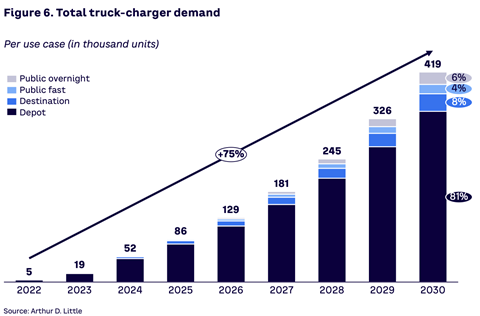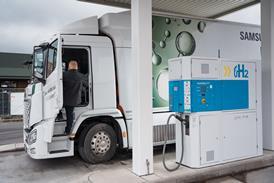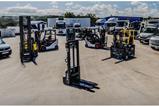By the year 2030, Europe is expected to have a substantial fleet of over 550,000 electric trucks, presenting a lucrative market opportunity for charging businesses.

According to a report released by management consultancy Arthur D Little, the demand for chargers in Europe is projected to soar from the current less than 10,000 installed units to an impressive 400,000 units by 2030, showcasing an average yearly growth rate of over 60% in the installed base.
While the transition to electric trucks gaining momentum, the industry currently relies on extra government subsidies and toll exemptions to make the Total Cost of Ownership (TCO) competitive with internal combustion engines, says the analyis. However, as electric vehicle reliability and charging infrastructure continue to improve, environmentally friendly legislation is expected to support further growth in the sector. Notably, advancements in battery and charging technology, driven by the passenger automobile industry, are contributing to this upward trajectory.
A significant market opportunity lies in megawatt charging facilities along highways and key logistical hubs, such as ports and distribution centres. These often require grid connections in the double-digit MW range, exceeding the capabilities of the current medium-voltage grid. Consequently, global DC charger manufacturers are poised to capitalise on these circumstances, the report continues.
Depot chargers are expected to dominate the charging landscape, accounting for over 80% of installed chargers by 2030. However, alternative charger types are projected to gain importance as longer-haul operations become more technically viable in the coming decade. It is worth noting that depot charging will contribute less to the revenue pools, as the hardware costs will be lower and power requirements reduced.
According to Arthur d. Little’s analysis, approximately 41% of the estimated revenue pools for truck charging in 2030 will be related to the depot charging use case. This is due, in part, to the relative affordability and reduced power consumption of the hardware.
The revenue streams associated with hardware are predicted to grow significantly, reaching around a billion euros by 2025 and tripling to €800 million (US $870 million) by 2030. These revenue projections predominantly revolve around DC charging hardware, demonstrating the immense potential in the electric truck charging sector.


















